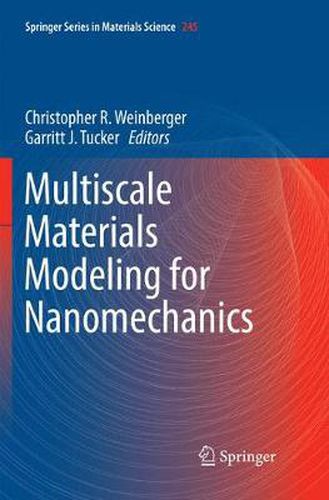Readings Newsletter
Become a Readings Member to make your shopping experience even easier.
Sign in or sign up for free!
You’re not far away from qualifying for FREE standard shipping within Australia
You’ve qualified for FREE standard shipping within Australia
The cart is loading…






This title is printed to order. This book may have been self-published. If so, we cannot guarantee the quality of the content. In the main most books will have gone through the editing process however some may not. We therefore suggest that you be aware of this before ordering this book. If in doubt check either the author or publisher’s details as we are unable to accept any returns unless they are faulty. Please contact us if you have any questions.
This book presents a unique combination of chapters that together provide a practical introduction to multiscale modeling applied to nanoscale materials mechanics. The goal of this book is to present a balanced treatment of both the theory of the methodology, as well as some practical aspects of conducting the simulations and models. The first half of the book covers some fundamental modeling and simulation techniques ranging from ab-inito methods to the continuum scale. Included in this set of methods are several different concurrent multiscale methods for bridging time and length scales applicable to mechanics at the nanoscale regime.
The second half of the book presents a range of case studies from a varied selection of research groups focusing either on a the application of multiscale modeling to a specific nanomaterial, or novel analysis techniques aimed at exploring nanomechanics.
Readers are also directed to helpful sites and other resources throughout the book where the simulation codes and methodologies discussed herein can be accessed. Emphasis on the practicality of the detailed techniques is especially felt in the latter half of the book, which is dedicated to specific examples to study nanomechanics and multiscale materials behavior. An instructive avenue for learning how to effectively apply these simulation tools to solve nanomechanics problems is to study previous endeavors. Therefore, each chapter is written by a unique team of experts who have used multiscale materials modeling to solve a practical nanomechanics problem. These chapters provide an extensive picture of the multiscale materials landscape from problem statement through the final results and outlook, providing readers with a roadmap for incorporating these techniques into their own research.
$9.00 standard shipping within Australia
FREE standard shipping within Australia for orders over $100.00
Express & International shipping calculated at checkout
This title is printed to order. This book may have been self-published. If so, we cannot guarantee the quality of the content. In the main most books will have gone through the editing process however some may not. We therefore suggest that you be aware of this before ordering this book. If in doubt check either the author or publisher’s details as we are unable to accept any returns unless they are faulty. Please contact us if you have any questions.
This book presents a unique combination of chapters that together provide a practical introduction to multiscale modeling applied to nanoscale materials mechanics. The goal of this book is to present a balanced treatment of both the theory of the methodology, as well as some practical aspects of conducting the simulations and models. The first half of the book covers some fundamental modeling and simulation techniques ranging from ab-inito methods to the continuum scale. Included in this set of methods are several different concurrent multiscale methods for bridging time and length scales applicable to mechanics at the nanoscale regime.
The second half of the book presents a range of case studies from a varied selection of research groups focusing either on a the application of multiscale modeling to a specific nanomaterial, or novel analysis techniques aimed at exploring nanomechanics.
Readers are also directed to helpful sites and other resources throughout the book where the simulation codes and methodologies discussed herein can be accessed. Emphasis on the practicality of the detailed techniques is especially felt in the latter half of the book, which is dedicated to specific examples to study nanomechanics and multiscale materials behavior. An instructive avenue for learning how to effectively apply these simulation tools to solve nanomechanics problems is to study previous endeavors. Therefore, each chapter is written by a unique team of experts who have used multiscale materials modeling to solve a practical nanomechanics problem. These chapters provide an extensive picture of the multiscale materials landscape from problem statement through the final results and outlook, providing readers with a roadmap for incorporating these techniques into their own research.